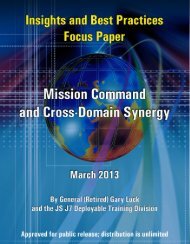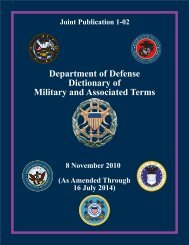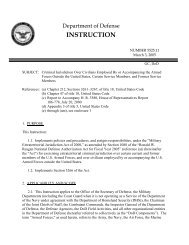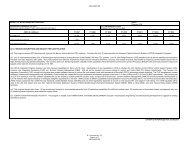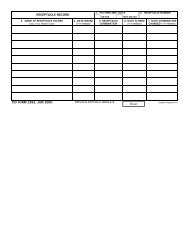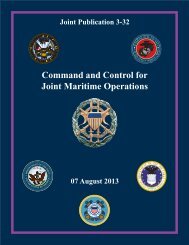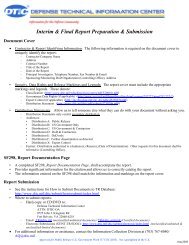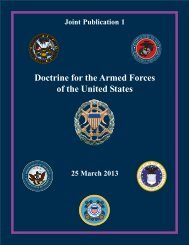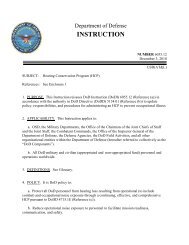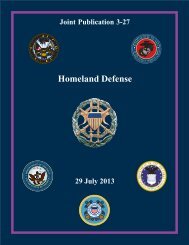JP 3-16, Multinational Operations - Defense Technical Information ...
JP 3-16, Multinational Operations - Defense Technical Information ...
JP 3-16, Multinational Operations - Defense Technical Information ...
You also want an ePaper? Increase the reach of your titles
YUMPU automatically turns print PDFs into web optimized ePapers that Google loves.
Chapter II<br />
b. MNFCs should integrate and synchronize their operations directly with the activities<br />
and operations of other military forces and nonmilitary organizations in the OA. All MNTF<br />
commanders are responsible to plan and conduct unified actions IAW the guidance and<br />
direction received from the national commands, alliance or coalition leadership, and superior<br />
commanders.<br />
c. The MNF will attempt to align its operations, actions, and activities with NGOs<br />
operating in a country or region. NGOs may be precluded from coordinating and integrating<br />
their activities with those of an MNF in order to maintain their neutrality.<br />
d. Training of forces within the MNTF command for specific mission standards<br />
enhances unified action. The MNFC should consider establishing common training modules<br />
or certification training for assigned forces. Such training and certification of forces can<br />
occur either prior to or after deployment to the MNTF OA. Certification of forces should be<br />
accomplished by a team composed of members from all nations providing military forces to<br />
the MNFC.<br />
e. Nations do not relinquish their national interests by participating in<br />
multinational operations. This is one of the major characteristics of operating in the<br />
multinational environment. Commanders should be prepared to address issues related to<br />
legality, mission mandate, and prudence early in the planning process. In multinational<br />
operations, consensus often stems from compromise.<br />
4. Overview of <strong>Multinational</strong> Command Structures<br />
No single command structure meets the needs of every multinational command,<br />
but there is one absolute: political considerations will heavily influence the ultimate<br />
shape of the command structure. However, participating nations should strive to achieve<br />
unity of command for the operation to the maximum extent possible, with missions, tasks,<br />
responsibilities, and authorities clearly defined and understood by all participants. While<br />
command relationships are fairly well defined in US doctrine, they are not necessarily part of<br />
the doctrinal lexicon of nations with which the US may operate in multinational operations.<br />
a. Organizational Structure. The basic structures for multinational operations fall into<br />
one of three types: integrated, LN, or parallel command.<br />
(1) Integrated Command Structure. A good example of this command structure<br />
(see Figure II-3) is found in NATO where a strategic commander is designated from a<br />
member nation, but the strategic command staff and the commanders and staffs of<br />
subordinate commands are of multinational makeup. The key factors in an integrated<br />
command are:<br />
(a) A designated single commander.<br />
(b) A staff composed of representatives from all member nations.<br />
(c) Subordinate commands and staffs integrated into the lowest echelon<br />
necessary to accomplish the mission.<br />
II-4 <strong>JP</strong> 3-<strong>16</strong>



